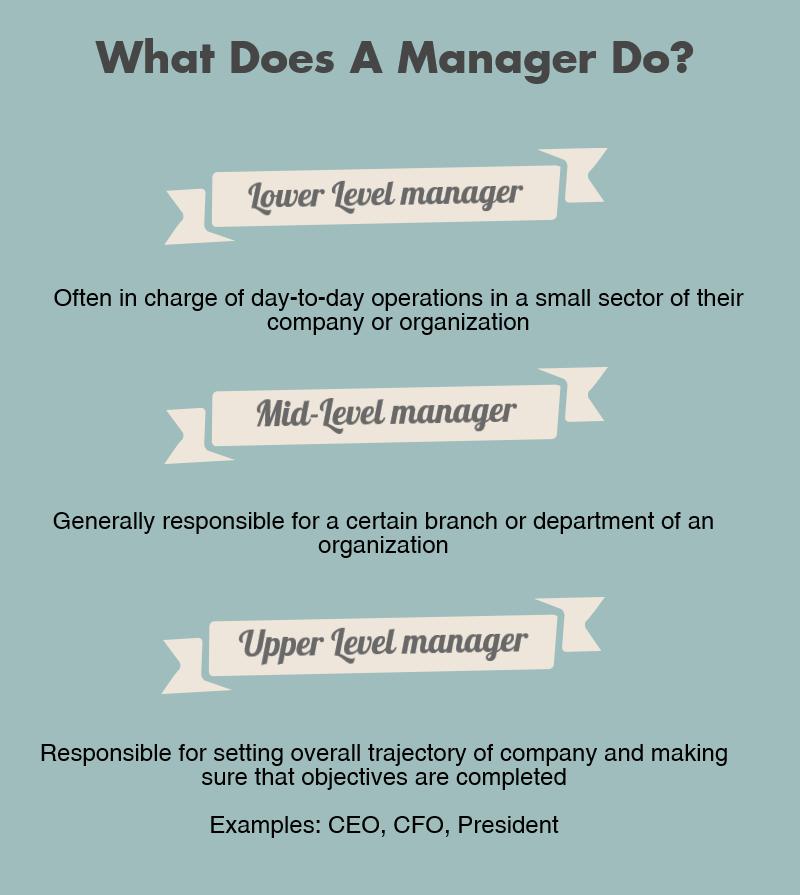Being a good manager can be stressful, especially when it comes to being a new manager. The pressure of the situation can become overwhelming as responsibilities build up; in this article, we’ll cover the basics so you can be sure you have your management bases covered.
What Is A Manager
The definition of a manager changes depending on the company or organization in which they manage. Overall, a manager is in charge of administration and/or controls parts of their company or organization.

How To Become A Manager?
- Find a company or organization in the field which you aspire to become a manager, and get a job in that field.
- Perfect your skill. One great way to become a manager is to learn the process that you will manage. This not only qualifies you to teach others to do the same thing, but gives you the skillset to recognize a job well done and coordinate multiple workers to guide a larger vision. This is a keystone of management.
- Show your worth by constantly producing good work. Remember that managers are hard workers and are often promoted from within.
- Don’t be afraid of new challenges. If your current manager proposes a new project with aspects that you are not familiar with, take them in stride. Pushing beyond your comfort zone means you’re ready to start delegating tasks that have become routine for you. Next thing you know, you have a team working under you.
- Be outgoing and creative. Pitch new, different ideas to your manager. Show him/her that you are putting in extra effort to help your company.
- Make it known that you want more responsibility. Sometimes, moving into a management role can be as simple as speaking up and making your intentions known.
- Keep up with your company’s internal chatter. If you know there is a new management opportunity opening up, speak to your superiors and submit yourself for the job. There are most likely multiple candidates for the job, so do not wait for the job offer to come to you.

What Does A Manager Do?
Lower-Level Managers
A lower level manager is usually in charge of day-to-day operations in a small sector of their company or organization. This could range from being a manager at Starbucks and overseeing order shipments and employee shift schedules, to being a manager of a printer paper distributor.
Lower-level managers generally have a few main responsibilities such as assigning tasks to individual team members and checking the quality of their work.
In larger organizations, ground-level managers usually report up to the mid-level manager, who is responsible for guiding the vision of the department.
Mid-Level Management
Mid-level managers are generally responsible for a certain branch or department of an organization.
For example, in a large software company, there may be a number of sales teams, each of which is looked over by a lower level manager. These managers report to the mid-level manager, who is responsible for the sales department as a whole.
His or her’s biggest concern is making sure that the teams below them are reaching their benchmarks.
Upper-Level Management
Higher level managers include the positions of the:
- Chief Operating Officer
- Chief Executive Officer
- Chief Financial Officer
- President
- Vice President
Those who hold these positions are responsible for setting the overall trajectory of a company and making sure that overarching objectives are successfully completed.
Below these high level managers are the middle level managers, which are usually the liaisons between the lower level managers and the higher level managers.

How To Be Good Manager?
The idea of a good manager can change depending on which type of organization or company you work for. That being said, there are a few things that can help you layout a solid foundation to becoming a good manager.
- Stay Organized
The process of becoming a manager can be a time consuming task; you are no longer only responsible for your personal schedule, but you have an entire new group of people to think about, so it is necessary that you have an organized mindset.
- Connect With Your Team
Having a strong relationship with your team is key. If your employees can trust you, then they will be more likely to work harder and stay happier. When people feel supported by their management team, they thrive. Try these team building exercises to get started: 33 Team Building Exercises.
- Be Transparent
Let your team know what’s happening, whether that be positive or negative. When you treat individuals on your team as part of a whole, they’ll feel more valued and be more motivated to work toward collective goals. Employees enjoy being in the loop! Even if it might not feel directly relevant to their work, sharing updates about the company can help clarify an individual’s understanding of the importance of their role.
- Know Your Own Strengths And Weaknesses
You know that you have qualities which make you management material and that there are some things you could improve upon. If, for example, you know that you are great at motivating people, but struggle with time management, create an office wide competition. Set a specific time limit for a new project and provide a prize for the employee(s) that complete the project. Also, don’t be shy to share your weaknesses with your employees. Nobody is perfect, and your team will appreciate the fact that you’re making an effort to grow.
- Praise Your Employees
Remember that your employees are people who need motivation and praise like anyone else, so make sure your employees know that they are appreciated. This will also help to create valuable connections with your employees.
- Find Your Personal Leadership Style
You might hear different things from different people when it comes to a management leadership style. You might have had a management mentor who had a style that you liked and would like to mimic, but you shouldn’t be afraid to experiment with other personal leadership styles. Check out some managerial style suggestions below.

Managerial Styles – Types of Managers
As stated before, coming up with your leadership style is very important, but finding the style that is perfect for you can take some trial and error.
The delegating leadership style is a style of leadership where a group leader assigns projects or assignments to their employees and gives them free reign to work.
Laissez-faire management is when a team leader allows their group members to feel independent while working, giving them the opportunities to flourish in their work environment.
Coaching leadership involves a manager taking an educational and mentor-like role. Coaching involves encouraging employees to develop their strengths to improve their performance.
Bad Management Styles
There are a variety of good management styles, but there are also several bad management styles. Remember that you can always change your management style, and following one of these styles doesn’t mean you are a bad manager, but that you can improve your leadership style.
1. Helicopter Leadership
Watching over everything your employees do and constantly re-doing or simply doing their work because you believe you can do it “better” can be very stressful for employees and make them feel that you don’t have any trust in them. If you are a helicopter leader, your employees may also take advantage of your need to change their work – they may not do their best work or not even complete it!
2. Absent Leadership
Delegation leadership can turn into absent leadership if you give away all your responsibilities and find yourself not doing anything. If you aren’t in the office very often or work offsite, you can risk being an absent leader. This can lead your employees to slack off or desire a more hands on manager. Absent leadership can cause your team to feel alone and not connected to the rest of the company.
3. Aggressive Leadership
There’s positive motivation in an office, but then there is also pure aggression. Stay firm, not aggressive. An aggressive leader may become verbally or physically aggressive to get their point across, neither of which is safe or appropriate in the work place. Fear may drive employees to complete their work, but respect for their manager will drive them to do their best work.
4. Passive Leadership
If your leadership style is more along the lines of not caring, then your team is likely to adapt. If it looks like you don’t want to do anything, then your employee’s productivity will also suffer. A passive leadership style can work if your team is already motivated, but in this case, one of these motivated employees may rise in the ranks and possibly replace you by showing their passion and initiative.

Tips For New Managers
Being a new manager can be taxing, and you might find yourself constantly second guessing everything that you do. To help you through this transition, here are several tips to make a strong start as a good manager.
Get To Know Your Employees
An office environment is filled with different interpersonal connections; as a strong manager, it is important to get to know the different members of your team. Knowing little facts and tidbits about your employees will not only help you build trust, but it will also help you with knowing who you should assign different projects to.
Be Mindful Of The Age Gap and Long Standing Employees
In today’s workforce many new managers are younger than their employees. This can lead to some inter-office resentment which can be avoided by respecting your “elders” and other employees who have been at the company for an extended period of time.
Be Mindful of Diversity
There are most likely going to be people at your job that are different than you. With that being said, it is your job to create a comfortable work environment for everyone in the office.
Communicate With Your Team
Let your team know what’s happening in the office and in your company; this includes good news and bad news. Communication also includes hearing what your team has to say; make sure to listen to their comments and their concerns. If you’re an upper-level manager, try arranging some skip-level meetings to get to know more individuals in your new company. Here’s a quick guide to skip level meetings to get you started if you need help.
Be Confident In Your Team and In Yourself
Being new may lead you to over manage, which can make your team feel like their skills aren’t valued. Know that everyone in your office is there because they can do their job, and know that you can do the same thing. You were hired as a manager because you have strong managerial skills, so have faith in what you can do and the abilities of the people around you!

No matter if you are an new manager or a managerial pro, you can always improve your leadership skills.
Remember the key to being a good manager is to be prepared.
There are many different types of managers as well as management styles, and finding the one that’s right for you may not come right away. Just remember, the transition into a management position and adjusting the way you manage your employees is a long, yet rewarding process.
Managers can always use a little extra help with time management and employee communication. The perfect prioritization tool for any manager is Priority Matrix!
Priority Matrix makes it easy to lead your team (whether local or remote) efficiently, allowing them to have control over their responsibilities while still showing you everything they’re working on.
Try Priority Matrix for free and give your team the professional and creative freedom they need to thrive and you the power to be the best manager you can be!
Full Infographic

